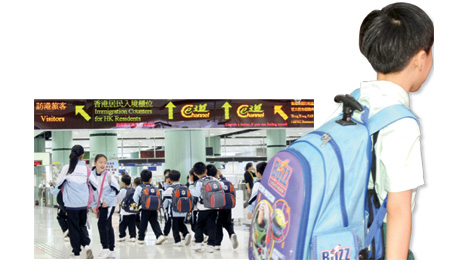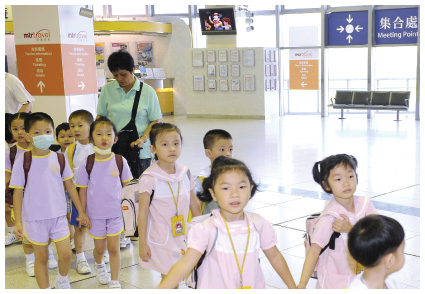Budding hopes for the future
Updated: 2011-03-17 07:12
By Steven Chen(HK Edition)
|
|||||||||
|
Students queue up to cross the border at the Lok Ma Chau Control Point. Provided to China Daily |
|
Cross-border students wait for their school buses at a meeting point of MTR Lo Wu Station. GIS Photo |
The future of Hong Kong rests in the hands of a young generation whose family ties with the mainland may be closer than they are to the SAR. But these "cross-border" children, accounting for a large portion of the newborns at city hospitals, represent the hope for the future. Reports Steven Chen.
If you happen to be crossing the border into Lo Wu late in the afternoon on any weekday, don't be surprised if you're suddenly confronted by dozens of youngsters no taller than your knee, joining you on your way to the mainland.
Dressed in matching windbreakers, carrying backpacks and travelling in groups of 20 or so, these kindergarten and primary school children are part of the growing number of cross-border students who live in Shenzhen but commute to Hong Kong for school every day.
Cross-border study, which has its origins in the 1980s when Hong Kong men first began finding partners on the mainland in significant numbers, has exploded during the last few years, with the number of students making the daily trip increasing from 3,800 in 2008 to 10,200 in 2009 and 10,800 in 2010. This recent surge can be traced back to 2001, when an earlier court ruling, giving children of mainland parents but born in the SAR the right to live in Hong Kong, set in motion a dramatic rise in the number of mainland mothers coming to the city to give birth.
Figures from the Census and Statistics Bureau bear this out, with data showing that the total number of babies born in Hong Kong to mainland parents has grown, from 7,810 in 2001, to nearly 42,000 in 2010.
Significantly, while the number of children born to families with a mainland mother and Hong Kong father has remained relatively stable over the years, with 7,190 in 2001, and 6,213 in 2009, the number of children born to families of which both parents are from the mainland has leapt, from 620 in 2001, to 29,766 over the same period. In 2010, 35,979 babies born in the city were born to such families.
That these couples chose to have their children in Hong Kong, sometimes in direct competition with local mothers - because of the city's reputation for quality healthcare, good education with a focus on English, and better tertiary education and opportunities for travel in the future, sometimes, has been widely acknowledged.
Less known, however, is that the huge increase has raised the number of babies, born in the SAR to families where one or both parents are from the mainland, to nearly 48 percent of the total, which was 82,095 in 2009 and 88,500 in 2010.
"This means that (nearly) one in every two children born in Hong Kong is born to mainland parents," says Cheung Yuk-ching, program director at the International Social Services (ISS) center in Sheung Shui.
With the trend likely to continue, and over half of these families expressing a desire for their child to grow up in the city, the group represents a powerful demographic that will have a major influence in future years. Ensuring these future members of the workforce adapting to life in the city, including its language and culture, is now a hot button issue, which social services centers like the ISS, schools and the parents themselves are keen to address.
"Cross-border students can be split into two (main) groups," says Cheung, whose center provides support services to cross-border families in distress. "Children of families with the father from Hong Kong and families with both parents from the mainland. Families with a Hong Kong father are usually working class families earning HK$10,000 a month. The fathers are truck drivers or work in construction or a restaurant and the mother is very young.
"We see a lot of children facing difficulties in these families. There is fighting, spousal abuse, child abuse and financial and social difficulties. Sometimes the child is raised by the mother because the father has left.
"Children from these families may have difficulty living in Hong Kong. Optimistic students see it as a chance to live in a new city and make new friends. But some students suffer from discrimination and difficulties because lessons are in Cantonese. They find it hard to make friends because they have to return to the mainland each day and family finances mean they cannot afford to come to Hong Kong (just) to enjoy the city."
With mainland mothers often unfamiliar with Cantonese and Hong Kong values, creating problems in communicating even with their own husbands, children can grow up in tense households that straddle two sets of customs and cultures, says Cheung.
Sometimes separated from the husbands for long periods of time and without access to services, the mothers may have difficulty coping, which, in turn, affects the family.
Because of keen competition for placements in less expensive schools, "older students near school leaving age may have difficulty finding a school after reaching 15 or 16", she adds. "Their families cannot afford to pay private school fees so they might miss out."
Children whose parents are both from the mainland are typically better off, she says.
"These parents are professionals or have businesses and are middle-class, by mainland standards."
However, with often neither parent originally from Guangdong province and therefore unable to speak Cantonese, these children, typically younger and in kindergarten or primary school, may have even more difficulty with their studies.
This disadvantage is offset by the family's higher income, with some parents able to send their children to after-school tutors or even better schools, she says, but the final outcome is not certain.
"Hong Kong's education system is different to the mainland," says Shirley Liu, who teaches at Fung Kai No 1 Primary School, one of the many schools in Sheung Shui catering to cross border students. No 1 and its sister site, Fung Kai Innovative School, have a combined total of 1,500 students, 30 to 40 percent of whom live on the mainland.
"Classes are in Cantonese, except for our Putonghua class, so (cross-border) students find it difficult in the first and sometimes second terms. After this, they are able to catch up, but some students still have problems."
Alison Lau, Vice-Principal of Innovative, agrees, and says her teachers are working on their Putonghua skills so they can communicate better with students. She estimates that 30 percent of her 700 students cross the border each day.
"Mainland students can be passive, so it takes time for them to get used to the local system, which can be very busy," says Liu.
Their biggest problem is adapting to the local culture and fitting in with other students who can discriminate and bully, she adds. Older cross-border students, eager to be seen as locals and influenced by their parents' admiration for Hong Kong, often see themselves as inferior and may become confused with their identity.
To alleviate the problem, "parents need to get involved, take time to understand their children's situation and be supportive".
With parental input so important, community centers like the ISS are playing an increasingly vital role in helping families in trouble.
Services provided include counselling for families and for individuals, establishing sister centers in Shenzhen and organizing extra-curricular activities for families who are financially strapped.
"Anything that helps keep families together," says Cheung, who is disappointed with the level of support from the government so far and says additional funding and manpower are sorely needed.
And with the city's healthcare system and other perceived advantages proving too alluring for mainland parents to abandon, border towns like Sheung Shui and Sha Tau Kok are likely to see more and more cross-border students in coming years.
According to government surveys, 87 percent of Hong Kong father/mainland mother households plan to raise their children as Hong Kong citizens while 61 percent of mainland father/mainland mother households intend to do the same.
This influx of students arguably boosts the fortunes of local schools that are now turning away potential students as a result of an abundance of applicants. It also allows Hong Kong, with a fertility level now well below the level required to replenish its population, to maintain a positive population growth vital for its long term economic health.
While the increasing number of young travelers poses challenges to the city's services, "Hong Kong also benefits," agrees Cheung. "They can't be ignored. These children are the city's future. We need more funding, more programs, more services to ensure that they adapt to life in Hong Kong, and grow up to be well behaved citizens and productive members of society."
(HK Edition 03/17/2011 page4)

